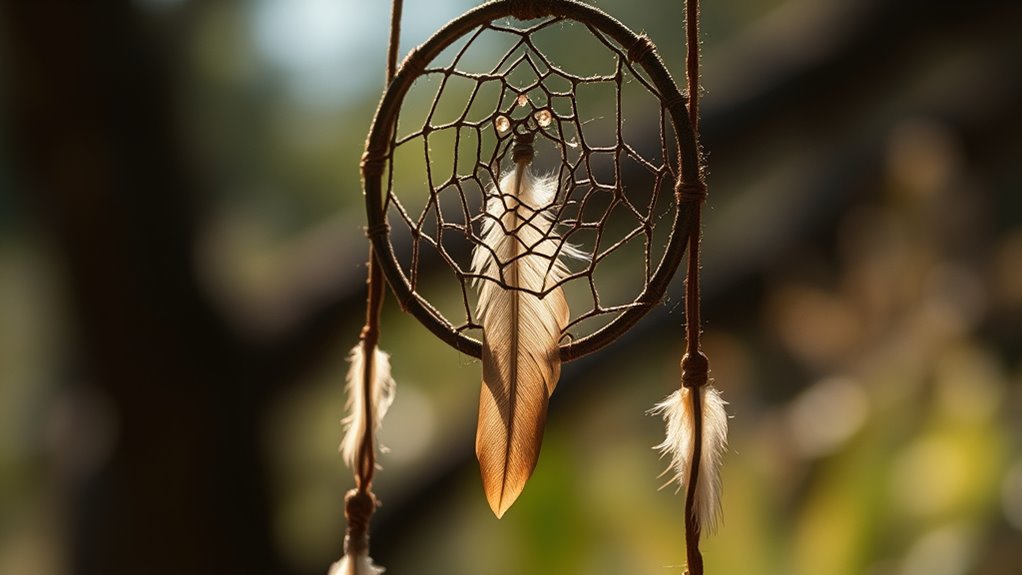Dreamcatchers symbolize protection, hope, and spiritual balance rooted in Native American traditions. They represent the circle of life, filtering out negative dreams while allowing positive ones to flow through. To respect this sacred object, learn its cultural meaning, buy from Indigenous artisans, and treat it with reverence. Appreciating its true significance helps preserve its spiritual importance. If you continue exploring, you’ll discover how to honor and honor this meaningful tradition properly.
Key Takeaways
- Dreamcatchers symbolize protection, hope, and spiritual balance rooted in Native American traditions.
- The web traps negative dreams, while feathers allow positive dreams to flow to the sleeper.
- Respect the cultural origins by purchasing authentic, handmade pieces from Indigenous artisans.
- View dreamcatchers as sacred objects, not just decorative items, to honor their spiritual significance.
- Understand and preserve the tradition by learning its meaning and avoiding cultural appropriation.

Dreamcatchers are more than just beautiful decorations; they hold deep spiritual significance rooted in Native American traditions. When you hang a dreamcatcher in your space, you’re participating in a practice that has been passed down through generations, embodying more than just aesthetic appeal. At its core, the dreamcatcher is believed to influence dream symbolism, filtering out negative dreams and allowing positive ones to pass through. This belief isn’t just about protection but about fostering a sense of spiritual balance and well-being. The cultural significance of dreamcatchers extends beyond their visual appeal; they serve as symbols of hope, protection, and respect for Native American heritage.
Dreamcatchers symbolize hope, protection, and spiritual balance rooted in Native American tradition.
Understanding the spiritual meaning behind dreamcatchers requires acknowledging their origins. These intricate webs, often decorated with feathers and beads, are traditionally crafted by Indigenous peoples such as the Ojibwe, Lakota, and others. Each element in a dreamcatcher has a purpose rooted in spiritual symbolism. The circular frame represents the circle of life, emphasizing unity and the interconnectedness of all living things. The web inside the circle acts as a trap for bad dreams, preventing them from disturbing your sleep, while allowing good dreams to slide down the feathers to reach you. This symbolism underscores the dreamcatcher’s role as a spiritual safeguard, designed to protect your consciousness from negativity.
When you incorporate a dreamcatcher into your environment, it’s essential to do so with respect for its cultural significance. Many people mistakenly treat dreamcatchers as mere décor, ignoring their sacred origins. To honor the tradition, learn about its history and meaning, and consider purchasing from Indigenous artisans who craft authentic pieces. Wearing or displaying a dreamcatcher without understanding its significance can be seen as cultural appropriation, diminishing its spiritual value. By respecting the cultural roots, you show appreciation rather than commodification, ensuring the tradition remains meaningful and genuine.
In essence, a dreamcatcher is much more than a pretty object; it’s a spiritual tool imbued with rich symbolism and cultural importance. Recognize its role as a protector of dreams and a symbol of cultural identity. When you respect its origins and intention, you honor the heritage that gave birth to this meaningful craft. Whether you hang it in your bedroom or gift it thoughtfully, remember that it carries a legacy of protection, spiritual insight, and cultural reverence that deserves acknowledgment and respect.
Frequently Asked Questions
Are Dreamcatchers Suitable for All Age Groups?
Dreamcatchers are generally suitable for all age groups, given their cultural significance and protective symbolism. You should consider age appropriateness, especially for young children, to guarantee they understand its meaning and handle it respectfully. As long as you teach its cultural importance and encourage reverence, dreamcatchers can be meaningful decorations or gifts for everyone, fostering appreciation for Native traditions and spiritual values across generations.
Can Dreamcatchers Be Personalized With Modern Symbols?
You can definitely personalize dreamcatchers with modern symbols, but it’s important to contemplate cultural sensitivity. Symbolic customization allows you to reflect your personality, but make sure the symbols you choose respect the tradition’s spiritual significance. Research their meanings beforehand to avoid misappropriation. By blending creativity with respect, you honor the cultural roots while making your dreamcatcher uniquely yours.
What Are the Common Materials Used in Traditional Dreamcatchers?
You’ll find that traditional dreamcatchers are crafted using native materials like willow hoops, sinew or sinew-like threads, and natural feathers. These materials reflect craftsmanship techniques passed down through generations, emphasizing harmony with nature. By using these authentic components, you honor the cultural significance behind dreamcatchers. Remember, respecting these traditions involves understanding the importance of native materials and craftsmanship, ensuring you preserve their spiritual and cultural integrity in your creations.
How Can I Identify Authentic Native American Dreamcatchers?
Did you know that over 80% of handcrafted dreamcatchers are made with authentic craftsmanship? To identify genuine Native American dreamcatchers, look for detailed craftsmanship and natural materials like sinew and feathers. Respect their cultural significance by purchasing from trusted artisans or Native-owned stores. Authentic dreamcatchers often feature intricate web designs and traditional symbols, ensuring you honor their deep spiritual roots and preserve their cultural authenticity.
Is It Appropriate to Give a Dreamcatcher as a Gift?
Giving a dreamcatcher as a gift can be thoughtful, but you should consider its cultural significance and gift-giving etiquette. Dreamcatchers hold deep spiritual meaning for Native American cultures, symbolizing protection and positive energy. If you choose to gift one, do so respectfully and with understanding of its significance. It’s best to do so with genuine appreciation and awareness, ensuring you’re honoring the tradition rather than appropriating it.
Conclusion
As you carry the spirit of the dreamcatcher, think of it as a gentle guardian weaving a net of protection around your dreams. Respecting its tradition is like honoring a sacred flame—keeping its light alive and pure. When you embrace its meaning, you become a part of a timeless dance, where dreams and spirituality intertwine. Remember, you’re not just hanging a piece of art—you’re inviting sacred energy to guide and guard your nights.









